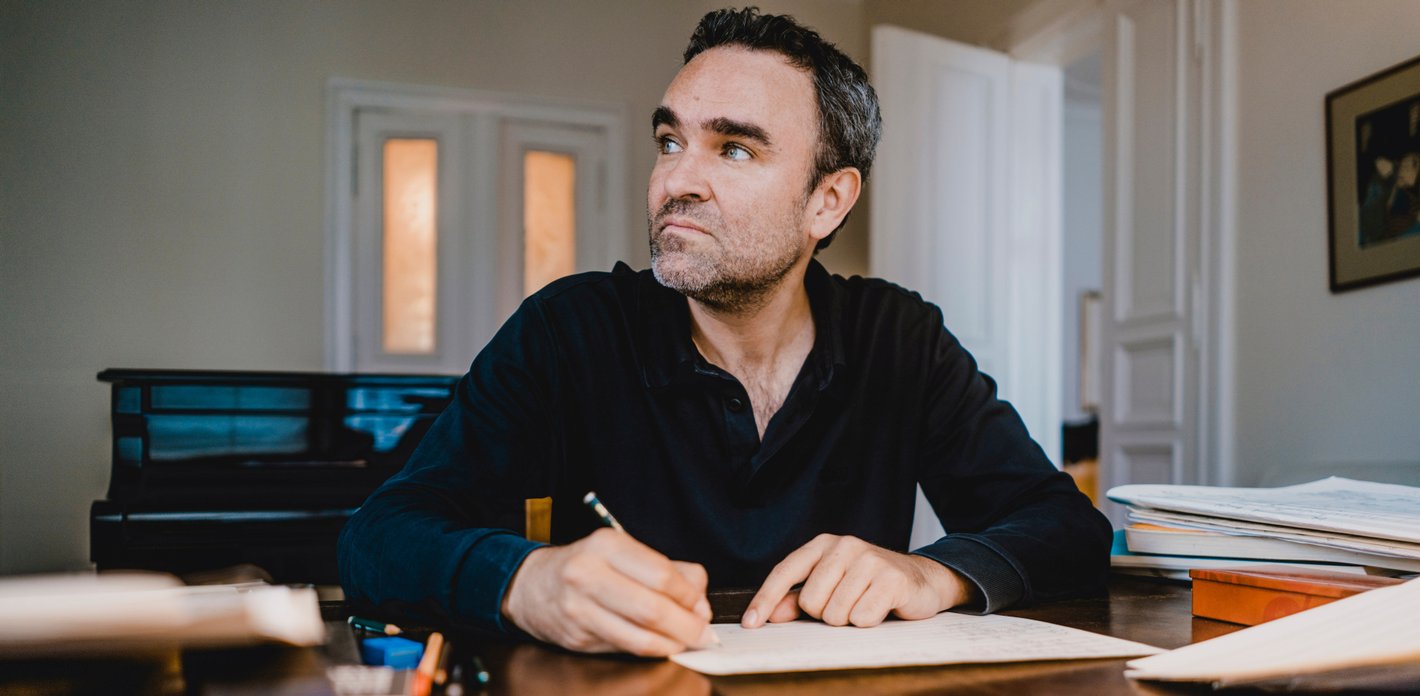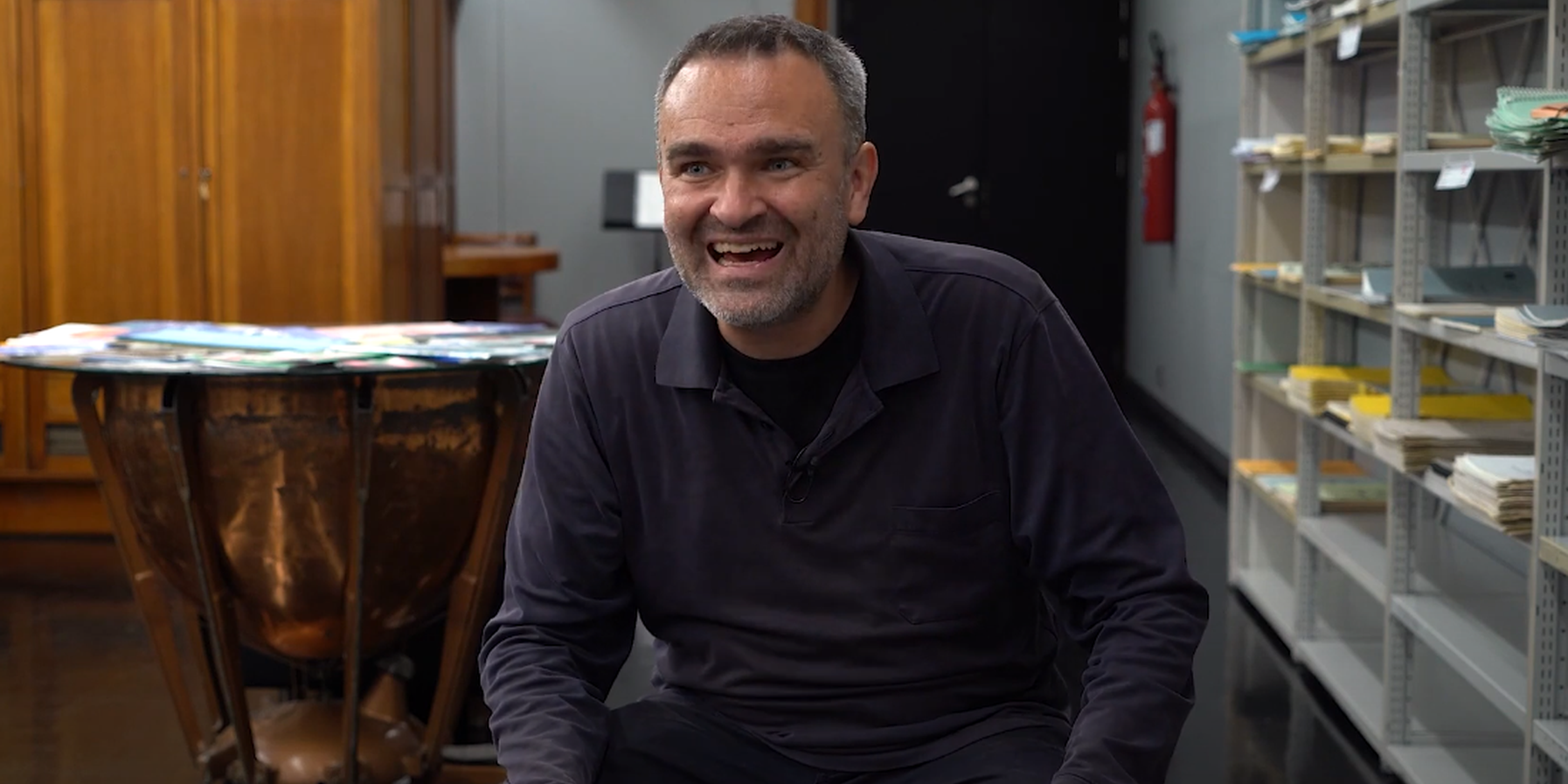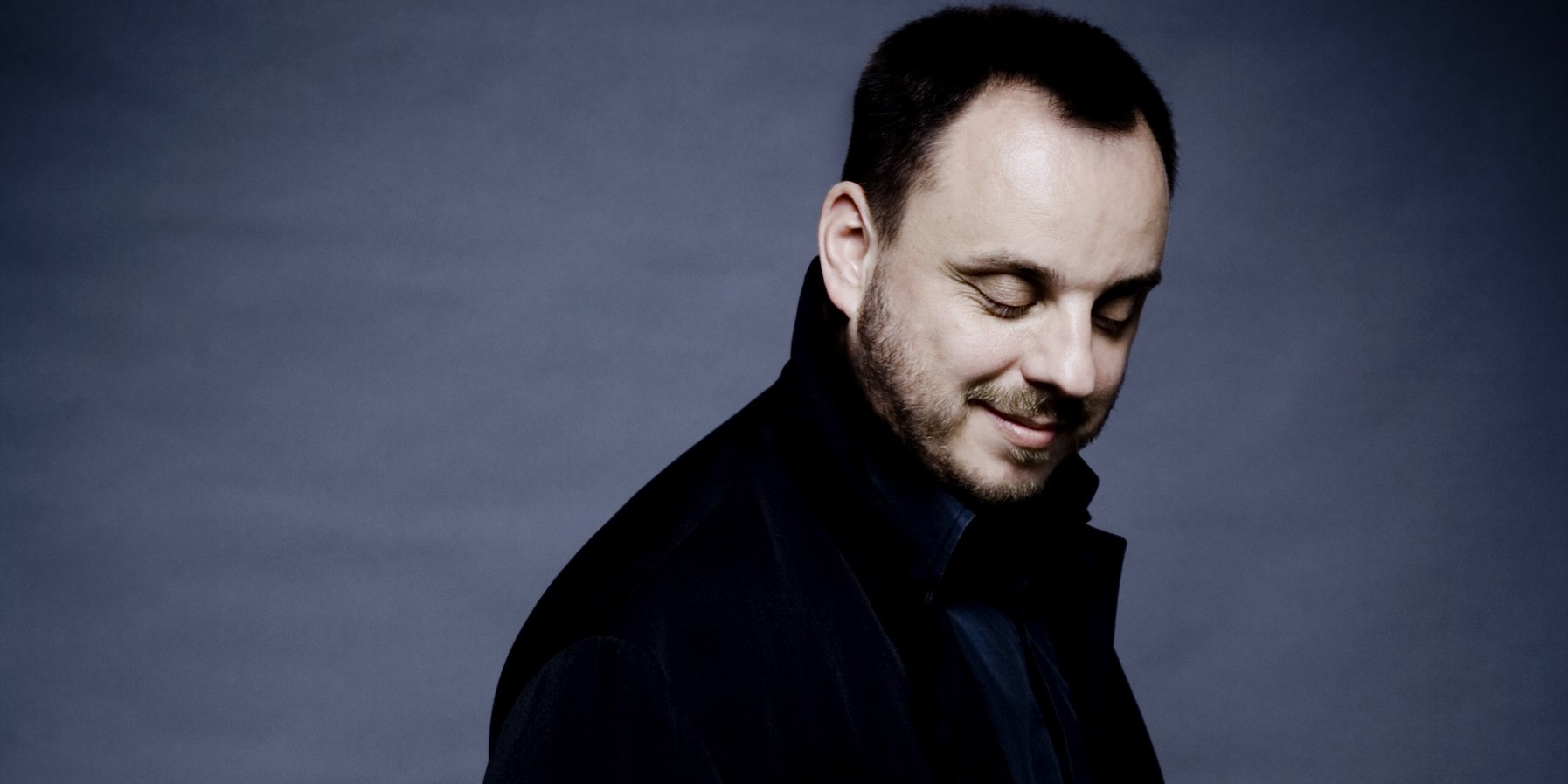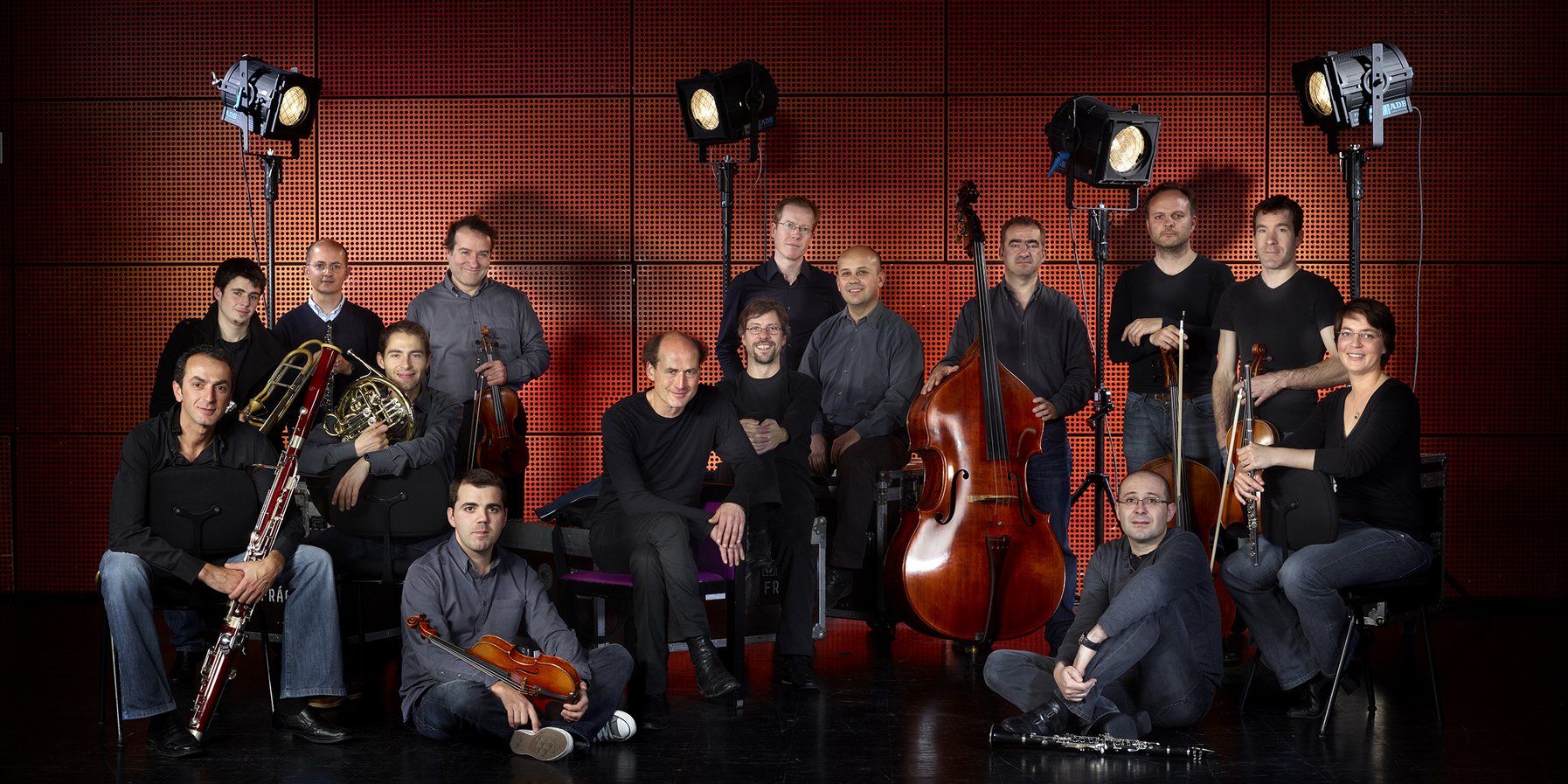He is one of today’s leading German composers, and also scores one success after another as a clarinettist and conductor: Jörg Widmann. The Munich native, who was born in 1973, focuses like no other artist of his generation on the work of Robert Schumann. A few weeks before the first performance of his »Schumannliebe« (4 October 2023, Casa da Música) – an instrumental arrangement of the great Romantic composer’s famous song cycle »Dichterliebe« –, he found the time for an interview, where he talks about his connection with Schumann and Heinrich Heine, about his new work and his high regard for the interpreters playing it for the first time.
AUDIO INTRODUCTION TO THE CONCERT ON 10 OCTOBER

Herr Widmann, your new work is a tribute to Robert Schumann. And »Schumannliebe«, a love of Schumann, permeates your entire oeuvre, from 1999’s »Fieberphantasie« through the »Elf Humoresken« to the »5 Albumblätter«, which you completed in 2022. What meaning does Schumann hold for you as a composer and interpreter?
From my point of view, he is one of the most important composers of all time. He is the poet in the world of music, thanks simply to his connection with literature that he got from his father. He grew up surrounded by books. Schumann once said about the writer Jean Paul: »I learnt more counterpoint from Jean Paul than from anyone else« - more, in other words, than from any musician. This literary reference really speaks to me. My early work »Fieberphantasie«, for example, refers to a musical phenomenon, and in Schumann’s music there is a certain temperature-curve melodics in both slow and fast movements that I only know in his case.
Has your connection with Schumann changed over the years?
I would say that the aspects that fascinate me, often eliciting both utter bliss and the deepest melancholy at the same time, have stayed the same. That hasn’t changed. But these things have grown in intensity since I gained a greater knowledge of Schumann’s work.
Was their one moment when you noticed as a composer that your love of Schumann can be heard in your music?
Well, it was actually the other way round. My clarinet teacher sat down at the piano and played Schumanns »Fantasiestücke« for me when I was probably a bit too young. I was infected for the rest of my life, and I worshipped the music to the extent that there was no way for it not to leave its mark in my own works.
Jörg Widmann shortly before the world premiere of his »Schumannliebe«
What prompted you to based a composition of your own on Schumann’s »Dichterliebe«?
It was an old dream of mine to produce an instrumental version of »Dichterliebe«. When I embarked on the project, I felt a mixture of fear and immense respect. Was I even allowed to do that? How could I possibly add anything to the original? Would I end up pasting over some of the beauties of the score? If there was nothing extra I could add, why do it at all? These doubts stayed with me right up to the last song. But the work of composition was a real trip in Baudelaire’s or Nietzsche’s sense of the word. In other words, I didn’t distort the original, but introduced greater clarity. Now the work is complete, I must say that I couldn’t have instrumented it any other way.
Did you already have ideas for an instrumental version of »Dichterliebe« in the past, ideas where you heard different timbres in your mind?
Absolutely. I often hear horns in Schumann’s music. Just as French horns and post horns are present in the Eichendorff poems to symbolise a mood that is still far away, or a premonition. Schumann loved horns himself. Then there is the oboe, that I place very much at centre stage in the woodwind section. Schumann frequently gives the melodies in the strangest and lowest registers to the oboe. Things like this play a role. I refer to Schumann’s complete oeuvre as well, taking into account specific instrumentation of his: hence the title »Schumannliebe«. In some songs you already hear other instruments in the piano part. In the wedding dance, for instance, the text says: »Flutes and fiddles can be heard, and trumpets blaring«. Or in »Hör’ ich das Liedchen klingen« – it must have a certain sound. I knew pretty quickly what overall sound I wanted for each piece, but actually formulating it was a complex task.
Did you get to know the work of poet Heinrich Heine, whose »Lyrisches Intermezzo« forms the basis of »Dichterliebe«, through Schumann?
My first encounter with Heine as a young man may indeed have come from hearing »Dichterliebe«. I spent a lot of time exploring Heine’s poetry, including his later works, and set it to music in a number of cycles. It’s nothing short of enchanting, the way Heine pulls off the balancing act between mocking irony and the deepest and most tender feelings – particularly in this cycle. In the combination of language and music I don’t think I know any other work where the two levels are so profoundly intertwined and where each level has great suggestive power in its own right.

»In the combination of language and music I don’t think I know any other work where the two levels are so profoundly intertwined.«
Jörg Widmann
How did you proceed with your instrumentation of »Dichterliebe«?
Not chronologically. I think I set nos. 2 and 4 to music first of all. No. 15 was already done when no. 16 was still a long way off because I wanted to work on »Ich grolle nicht« and »Im Rhein« before that. But it was interesting to see an ever denser interpretative network of references emerging. It’s a world in its own right, based obviously on my own interpretation. In some songs, for instance, I adopted motifs from other »Dichterliebe« songs, which Schumann doesn’t do. In »Hör’ ich das Liedchen klingen«, to name one example, I simply assert that the song that the two lovers remember is »Im wunderschönen Monat Mai«, which I then set in a very sad minor. Or in no. 15, which opens on such a fresh note: the positive mood is completely destroyed when he dreams his way into the place where this love will probably happen. Here, I took the liberty of using a motif that played a significant role in Schumann’s music, e.g. in the »Davidsbündlertänze«, »Kreisleriana« and so on. In the Eichendorff song cycle, the central passage in the text is the line »Ich wünscht’, ich wär’ ein Vöglein und zöge über das Meer« (I wish I was a little bird and could fly out over the sea). That is exactly the same vision: I can fulfil wishes in some kind of utopia that can’t come true here on Earth. I allot this motif to the flute, just as I cast in reminiscences of many other Schumann pieces where it makes literary and musical sense to me. E.g. the »Schnitterliedchen« from »Album für die Jugend«. I simply had to use that here! I placed the flowing quaver movement from this passage over the closing, calm music from »Aus alten Märchen winkt es«. It was amazing to see how organically this passage fitted in. The whole thing evolved as freely as a bird. But it nonetheless became my music in the service of the work it is based on.
MATTHIAS GOERNE SINGS SCHUMANN’S »DIE STILLE«
How closely did you stick to the original in your »Schumannliebe«, and how far did you allow yourself to depart from it otherwise?
It has to be said that »Dichterliebe« is one of the utmost achievements of all time as far as the combination of language and music is concerned. I realised this once more while I was working. Originally, I was going to write a lot more commentaries, interventions, transitions, intermezzi and so on. But in the end, with a few important exceptions, I abandoned this plan. The way one piece picks up where the previous one left off – all these connections are so brilliantly timed that they really need to be left as is. The style and freedom of my instrumentation is my interpretation, after a manner of speaking. But sometimes I also leave the tonality in the parts I added. And I use timbre in particular to give the music clear colour from today’s standpoint. However, I hope that my approach serves both the text and the music, as the title of the piece suggests.
What important exceptions are you referring to?
There are some preludes and postludes, as well as a very few examples of extremely brief additions to Schumann’s syntax. In just a couple of songs, e.g. before »Im wunderschönen Monat Mai«, there is a prelude that glides unnoticed into Schumann’s own prelude, so that ideally – that was my aim – the listener doesn’t notice when the Schumann starts. Only once the singer comes in is it clearly Schumann. Or »Im Rhein« – this is the river for him. As a young man, Schumann already dreamt he was drowning in the waters of the Rhine. And shortly before he was admitted to the asylum in Endenich near Bonn, he actually threw himself into the Rhine with suicidal intent. That’s something I wanted to make clear in a short prelude; I see »Im Rhein« in connection with the song that comes after, »Ich grolle nicht«. Schumann deliberately ends on a banal note in G major and C major, and I prolong this to a total length of 30 seconds. And with this motif »Ich grolle nicht«, there is a good deal of »grollen« (= (g)rumbling) in the postlude. I take the liberty of adding this commentary.
The preludes and in particular the postludes have a greater weight than in Schubert’s music, for example, and are characteristic of Schumann’s »Dichterliebe«.
The most expansive moment in the whole cycle is the piano postlude of the final piece, where the composer fantasises about how this love could work. We already notice this in the first piece, where the tension remains in the air and is not resolved. That prompted me to transfer the principle of »Im wunderschönen Monat Mai« to the final piece in the set: at the end, it’s resolved and yet unresolved at the same time. That is already Schumann’s commentary on the whole situation. Clara read and heard this piece in her wedding year, and it must have filled her with trepidation after the couple had waged a long and acrimonious legal battle against Clara’s father, who opposed their marriage. And it was in this same year that Schumann wrote this song cycle about a love that is not to be, or – something I noticed increasingly as I explored the score – is probably already over at the outset. It’s not my intention to interpret more than Schumann and Heine did. But these are songs about something utopian, a figment of the imagination, and I have tried to support and reinforce this by my instrumentation, which is sometimes celestial and sometimes drastic in character.

»My answer to your question whether I will let my father intimidate me again is: No, never!«
Clara to Robert Schumann, 26 December 1837
The cycle opens with an unresolved dissonance, which is unbelievably modern for its time.
If you just listen to Schumann’s first three notes, you would guess this is 20th century music, perhaps by a composer like Anton Webern, rather than a 19th century work based on tonality. And the modernity is everywhere! Schumann just about manages to make it sound like a simple song.
Do you also make use of new playing techniques to make this clear?
Absolutely. The piece opens with noise: I use air noises, sometimes »sul ponticello« (playing instruction for string instruments: bowing close to the bridge), when I think it’s appropriate, or »sul tasto« (bowing on the fingerboard). In »Ich hab’ im Traum geweinet«, the piano is resoundingly silent. Time afer time, it loses itself in a vacuum. But when the musicians play, I wrote the marking »col legno battuto« – beaten with the wood of the bow – into the score. And this is accompanied by rough and simultaneously empty air sounds from the brass section. But the rhythm remains unchanged. I do go in for exaggerations like this – though strictly speaking, they are not exaggerations: I hear effects like this in the Schumann as well. I try to bring out what I hear in the Schumann in my own instrumentation – that is one way of describing my approach. Then there are these typical displacements in Schumann’s syntax, such as the deferred syncopes in the piano part, which I exaggerate by employing a large number of bowed percussion instruments such as bowed crotales and the vibraphone, whose sound is heard with a delay of two or three seconds. To cite another example: in the opening song, the pianist’s right hand is diplaced at the line »Da hab’ ich ihr gestanden, mein Sehen und Verlangen«; it’s not in the place where any other composer would have written it. And I bring that out through sforzati and pizzicati. It took me ages to get the instrumentation right, but it was worth it in order to transfer these accents from a single pianist to 20 musicians, half of them playing crescendi, the other half diminuendi.
Did you learn anything new about Schumann from your study of »Dichterliebe« from a composer’s point of view?
Absolutely. One thing that only came to my attention while I was composing »Schumannliebe« was the explicit references to Bach in Schumann’s harmonics and in the progressions: this applies especially to »Im Rhein«, which is basically a Baroque overture. To emphasise this aspect, I added a harpsichord to these songs. Schumann was criticised by contemporaries for adhering to an outmoded model because he pays such obvious tribute to Bach and Handel in his music. Schumann was indignant and hit back with the statement that Bach and Handel would remain important for all eternity. »Dichterliebe« contains many obvious nods towards Bach, which was not entirely clear to me hitherto.
Your »Schumannliebe« was first performed by the Remix Ensemble Casa da Música under Peter Rundel with Matthias Goerne, and it can be heard again in the Elbphilharmonie on 10 October 2023 with the same artists. Did you have the Remix Ensemble in mind when you were working on the instrumentation?
Definitely. I know their sound: I’ve conducted the ensemble on several occasions, and have a high opinion of Casa da Música as a venue. So my work is connected with their sound – but I still challenge them to go beyond their limits. I enjoyed a highly inspiring exchange with Matthias Goerne about »Dichterliebe«, and benefited greatly from his experience with the cycle. As for Peter Rundel: he conducted the premiere of my first opera, »Das Gesicht im Spiegel«, 20 years ago. It was a high-risk project and a huge challenge for all concerned, so it was good to know that I was working with such trustworthy and familiar people once more.
Interview: Ivana Rajič, 14.09.2023









